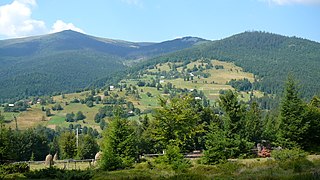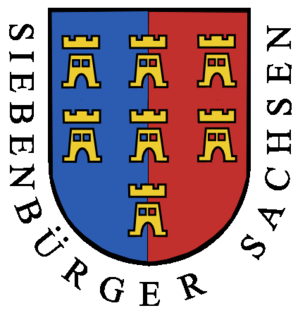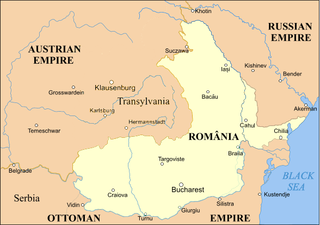| Look up Transylvanian in Wiktionary, the free dictionary. |
Transylvanian may refer to:
Contents
- anyone or anything related to Transylvania
| Look up Transylvanian in Wiktionary, the free dictionary. |
Transylvanian may refer to:
| This disambiguation page lists articles associated with the title Transylvanian. If an internal link led you here, you may wish to change the link to point directly to the intended article. |

Transylvania is a historical region that is located in central Romania. Bound on the east and south by its natural borders, the Carpathian mountain range, historical Transylvania extended westward to the Apuseni Mountains. The term sometimes encompasses not only Transylvania proper, but also parts of the historical regions of Crișana and Maramureș, and occasionally the Romanian part of Banat.
The Middle Ages in Romania began with the withdrawal of the Mongols, the last of the migrating populations to invade the territory of modern Romania, after their attack of 1241–1242. It came to an end with the reign of Michael the Brave (1593–1601) who managed, for a short time in 1600, to rule Wallachia, Moldavia, and Transylvania, the three principalities whose territories were to be united some three centuries later to form Romania.

Alba Iulia, is a city that serves as the seat of Alba County in the west-central part of Romania. Located on the Mureș River in the historical region of Transylvania, it has a population of 63,536.
Transylvania is a historical region in present-day Romania.

Turda is a city in Cluj County, Transylvania, Romania, situated on the river Arieș.
Unio Trium Nationum was a pact of mutual aid codified in 1438 by three Estates of Transylvania: the nobility, the Saxon (German) patrician class, and the free military Székelys. The union was directed against the whole of the peasantry, regardless of ethnicity, in response to the Transylvanian peasant revolt. In this typical feudal estate parliament, the peasants were not represented, and they did not benefit from its acts, as the commoners were not considered to be members of these feudal "nations".

The Transylvanian Saxons are a people of German ethnicity who were settled in Transylvania in waves starting from the mid 12th century until the late Modern Age. The Transylvanian "Saxons" originally stemmed from Flanders, Hainaut, Brabant, Liège, Zeeland, Moselle, Lorraine, and Luxembourg, then situated in the north-western territories of the Holy Roman Empire around the 1140s.

Gabriel Báthory was Prince of Transylvania from 1608 to 1613. Born to the Roman Catholic branch of the Báthory family, he was closely related to four rulers of the Principality of Transylvania. His father, Stephen Báthory, held estates in the principality, but never ruled it. Being a minor when his father died in 1601, Gabriel became the ward of the childless Stephen Báthory, from the Protestant branch of the family, who converted him to Calvinism. After inheriting his guardian's most estates in 1605, Gabriel became one of the wealthiest landowners in Transylvania and Royal Hungary.
The Prince of Transylvania was the head of state of the Principality of Transylvania from the last decades of the 16th century until the middle of the 18th century. John Sigismund Zápolya was the first to adopt the title in 1570, but its use only became stable from 1576.

The Germans of Romania or Rumäniendeutsche represent one of the most important ethnic minorities of Romania. During the interwar period, the total number of ethnic Germans in this country amounted to as much as c. 800,000, a figure which has subsequently fallen to c. 36,000.
Transylvania is a historical region in central and northwestern Romania. It was part of the Dacian Kingdom, Roman Dacia, the Hunnic Empire, the Kingdom of the Gepids, the Avar Khaganate and the 9th century First Bulgarian Empire. During the late 9th century, western Transylvania was reached by the Hungarian conquerors and later it became part of the Kingdom of Hungary, formed in 1000.
The Early Modern Times in Romania started after the death of Michael the Brave, who ruled in a personal union, Wallachia, Transylvania, and Moldavia – three principalities in the lands that now form Romania – for three months, in 1600. The three principalities were subjected to the Ottoman Empire, and paid a yearly tribute to the Ottoman Sultans, but they preserved their internal autonomy. In contrast, Dobruja and the Banat were fully incorporated into the Ottoman Empire.

The Principality of Transylvania was a semi-independent state, ruled primarily by Hungarian princes. Its territory, in addition to the traditional Transylvanian lands, also included the other major component called Partium, which was in some periods comparable in size with Transylvania proper. The establishment of the principality was connected to the Treaty of Speyer. However Stephen Báthory's status as king of Poland also helped to phase in the name Principality of Transylvania. It was usually under the suzerainty of the Ottoman Empire; however, the principality often had dual vassalage in the 16th and 17th centuries.

Saschiz is a commune in Mureș County, Transylvania, Romania. It has a population of 2,048: 88% Romanians, 5% Germans, 4% Hungarians and 3% Roma. It is composed of three villages: Cloașterf, Mihai Viteazu and Saschiz.
The Battle of Sződfalva or Battle of Sedfal field was fought on 25 July 1527 between voivodian Serbs, under Jovan Nenad, and the Transylvanian army of. In the battle, Jovan Nenad was defeated by a much larger force, and many of his troops dispersed into Syrmia after the defeat. When Ferdinand of Austria won, the Serbs maintained an autonomous principality in the area that lasted until 1540.
Principality of Transylvania can refer to:

The Transylvanian Diet was an important legislative, administrative and judicial body of the Principality of Transylvania between 1570 and 1867. The general assemblies of the Transylvanian noblemen and the joint assemblies of the representatives of the "Three Nations of Transylvania"—the noblemen, Székelys and Saxons—gave rise to its development. After the disintegration of the medieval Kingdom of Hungary in 1541, delegates from the counties of the eastern and northeastern territories of Hungary proper also attained the Transylvanian Diet, transforming it into a legal successor of the medieval Diets of Hungary.

The Principality of Transylvania, from 1765 the Grand Principality of Transylvania, was a realm of the Hungarian Crown and from 1804 an Austrian crownland ruled by the Habsburg and Habsburg-Lorraine monarchs of the Habsburg Monarchy. During the Hungarian Revolution of 1848, the Hungarian government proclaimed union with Transylvania in the April Laws of 1848. After the failure of the revolution, the March Constitution of Austria decreed that the Principality of Transylvania be a separate crown land entirely independent of Hungary. In 1867, as a result of the Austro-Hungarian Compromise, the principality was reunited with Hungary proper.

The Transylvanian Military Frontier was a territory in the Habsburg Monarchy. It was a section of the Habsburg Military Frontier.
The Diploma Leopoldinum was a legal document which determined the basic principles of the government of the Principality of Transylvania within the Habsburg Empire. The diploma was drafted by Miklós Bethlen, Chancellor of Transylvania. The Holy Roman Emperor, Leopold I, sanctioned it in Vienna on 16 October 1690. The diploma announced on 4th December 1691. The diploma restored civil administration in the principality, and confirmed the traditional liberties of the Three Nations of Transylvania, including the freedom of the four "received" religions.